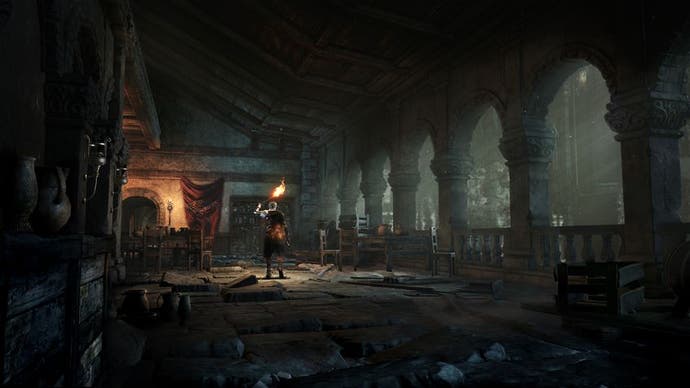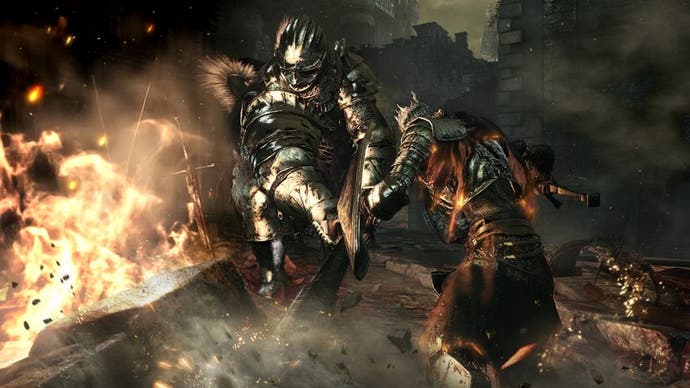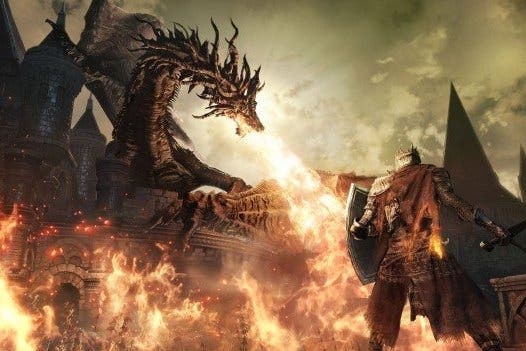Dark Souls 3 is familiar, and that's fine
But what waits around the corner?
Hidetaka Miyazaki isn't anything like I pictured him. I'm not really sure what I expected, but the image I had conjured up, of a quiet, brooding auteur responsible for the creation of nightmarish visions like the Gaping Dragon and Quelaag and Ebrietas, was far from the grinning figure who stands at the front of the room for our hands-off demo, bright-eyed, animated, and joking about PC malfunctions and Legolas from The Lord of the Rings.
The creator of Dark Souls and Bloodborne and now president of From Software talks candidly to the darkened room full of journalists, too - about how Dark Souls 3 isn't the last game in the series but that it will mark "a turning point" - partly because Miyazaki believes that it's "not a good idea" to continuously release new titles for the series, and also because it's the last From Software game to begin production before Miyazaki took on the role of president. He's co-directing Dark Souls 3 with Isamu Okano, who worked on, of all things, Steel Battalion, but the studio is keen to point out that Miyazaki is "taking lead on world-building and basic game feature direction, as well as visual design direction," while Ogano is "basically handling the mass production part, as well as the human resource control. The best way to explain is that Ogano-san is supporting Miyazaki-san's directions." Dark Souls 2 was not a Miyazaki creation, and many fans felt it suffered as a result. The studio, and Miyazaki himself, seem keen to avoid that perception this time around, and so, here were are, huddled together, to have the company president take us through a world that is at once both strange and instantly familiar.
The Souls games are not ones that take well to being demoed. They are, unequivocally, about finding your feet in a hostile world inch by inch and in your own time, and the euphoric feeling of defeating a boss or a particularly taxing enemy - the reason we keep returning to these crumbling kingdoms - isn't something that can be experienced vicariously.
Nevertheless Miyazaki is keen to try - but not without giving a PowerPoint presentation first. The initial few slides run through the basics - it's out on PS4, Xbox One and PC in early 2016, it'll comprise the standard mix of single player and online multiplayer, and the player is taking on the role of a 'dark hero' trying to kill the resurrected Lord of Cinder - glimpsed at the end of the trailer shown at Microsoft's E3 conference. The slides don't tell us anything we don't already know; bolded words like "withered beauty," "formidable difficulty," and "unique online systems" are familiar to anyone who's played or even glanced at a Souls game before. Miyazaki talks animatedly, however. He has a habit of looking to the ceiling as he speaks, as though searching for inspiration from a higher power. He mentions the fact that this is an apocalyptic world, teetering on the brink of Doomsday. Lordran, Boletaria and Drangleic were forsaken, Yharnam was in the throes of a violent death rattle, but this new world is seemingly gripped by something such more insidious.
Once the demo itself was finally underway, we found ourselves standing in on a paved rampart overlooking a grey labyrinth of densely packed castles and courtyards. The area is called the Wall of Iodeleth, and it looked very much like a cross between Yharnham and the Undead Burg. It didn't feel like anything we hadn't seen before; it was the standard dark medieval fantasy we've come to expect from the early stages of Souls titles. Corpses hung from nearby trees (in fact, on closer inspection the branches seemed comprised of corpses), a castle could be seen in the far distance, and, dampening my excitement somewhat, a couple of the nearby statues looked a little like a direct asset lift from Bloodborne.
We got the usual, "Any place you can see, you can explore" spiel before setting off, but more interesting was the impressive detailing on the character's armour - it seemed to constantly emit a subtle orange glow - and the non-aggressive NPCs that were milling around. As we walked and climbed further up the ramparts, there seemed to be a light falling of snow, but Miyazaki pointed out that it was, in fact, ash. The source of this wind-borne soot, it soon became clear, was a dead dragon ("perhaps it used to be the guardian of this castle" Miyazaki pondered), slowly desiccating under a faded sun. It's classic Dark Souls - calcified, monstrous, mournful.
From here we pass through a doorway and head into a darkened area. We light a torch in a flurry of sparks; shadows dance on the walls, and every flicker feels like a threat. A little further along, we come upon a tiny grave sunken into the main wall of the castle. Miyazaki explains that players can "offer flame" to these tombstones, thus using the grave as a landmark and uncovering a sliver of story through its inscription. This one reads "Grave of a nameless retainer, raised his sword for the Lord of Cinder." It doesn't mean much to us now, so we move on.
Before long we're out under a greying sky again, standing on one end of a narrow walkway dotted with multiple enemies we'd undoubtedly engage if we were to go any further. Miyazaki noted that the series often provides alternate routes to those willing to take risks and explore, so we ascend a set of nearby steps to try and find an easier path.

Instead, we find a dragon. Its claws are draped over parapets hanging above the walkway, the thin membrane of its wings stretched taut over the stone. It inhales, and we duck back down the stairs to avoid the plume of flame that arcs overhead and engulfs the parapet. Miyazaki grins wickedly as he admits that encountering a dragon at the early stages of Souls game is a favourite touch of his, and this one is a child of the decaying creature we passed by moments before. We aren't getting past this guy any time soon. However, as we turn and head back down the way we came, we discover that the dragon's attack has inadvertently toasted the crowd of enemies that were previously blocking our way.
In the ashes of the aftermath, we pick up a greatsword, and begin to test out the new adjustments to Dark Souls' combat system. The biggest of these thus far, a mechanic that seems to have been at least partially borrowed from Bloodborne, has players capable of deploying different stances for different types of weapon. It's not entirely clear how this will work yet, but in the case of the greatsword, players can perform a strong, two-handed upward stab motion which will actually launch enemies into the air.
From Software is calling this new mechanic 'Weapon Arts,' and it's designed to give specific arms additional, unique attacks. Essentially, it's adding a little something extra to the system regular Souls fans will now be intimately familiar with, without changing the basic mechanics too much - giving you more choice than simply 'normal' and 'heavy' attacks and contributing to the role-play element of the game. With a standard-looking straight sword, for example, you can enter into a 'ready' stance that will allow you to perform two special attacks; a heavy swipe to break an enemy's shield guard, and a running sweep to thrust them forward quickly. When we find a Legion Scimitar towards the end of the demo, we're able to dual-wield it with another and perform a spin attack, a move that can kill off multiple undead enemies at once. Miyazaki warns that it isn't a move you'd want to try on, say, a Knight (another Souls staple that returns in 3) - but used for a crowd-control on a bunch of low-level enemies, it's effective. Weapon Arts aren't exclusively the preserve of melee weapons, however; short bows can be fired quickly and consecutively during battle. You can still line up and take shots from afar, but this new streamlined mechanic will likely make them a much more viable option during prolonged, engaged combat.
While making our way to the final boss of the demo, we encountered a group of undead crowded around what looked like a makeshift altar. They ignored our presence completely, but as we approached for a closer look, an oozing, belching, tar-like monstrosity erupted from the altar, absorbing the nearby bodies in its wake. We don't last long against this creature and the dev are too conscious of time to give it a second go, but it feels like this could be a recurring event.

In Dark Souls 3's quieter moments, you can appreciate the clouds of ash and dust particles in the air, the quietly flapping folds of the character's attire, and the torchlight as it dances along the walls. These are the moments that really sell the world, for me at least, and it's hard to get a handle on them when developers are, understandably, pressed for time during a packed schedule. I suspect this world will only really begin to present itself when players are allowed to go hands-on later this year.
Finally, we reach the boss, hidden away in a mausoleum. Lurking up on the ceiling of this darkened space, this creature - I've written 'Dancer of the Forbidden Valley' in my notes but two other sites have written 'Frigid' and 'Flaming' in their previews and listening back to the audio, in between commentary, crashes of steel on steel and an ominous orchestral score it could honestly be any of the three - has Dark Souls written all over it. Shimmering ethereally, dressed in armour topped with a veil, its movements are graceful, fluid, feminine, and Miyazaki notes as much. It's also lightning-quick and armed with a flaming sword, and as the fight wears on its repeated attacks set fire to the arena - an inferno slowly licking its way up the pillars that surround us - it isn't apparent if that fire is actually damaging to the player, or if it's used more for dramatic effect.
You can see during this fight, too, that the player character seems to move faster than in previous Souls games. Not as fast as characters in Bloodborne, but rolls, dodges and backsteps certainly seemed nimbler. When the Dancer's health falls below a certain threshold, it will produce a second sword, an ash sword, and duel-wield for the remainder of the battle, upping its speed and aggression as a result. It seems clear by this point that ash will be a running theme throughout Dark Souls 3; it's thematically fitting, given the story of Dark Souls thus far and the player's quest to defeat the Lord of Cinder (again) - but Miyazaki isn't elaborating any further on it at this point. We don't beat the Dancer before the demo's end, either, but the developer playing makes a thoroughly decent go of it. I imagine I'm not the only person watching itching to take the controller from him, though.
Miyazaki smiles warmly as the demo ends, and there's a sprinkling of clapping. Like I said, these games don't tend to demo well, but Dark Souls 3 seems to have built a solid foundation on what's come before it. It's very familiar territory at this point, but that doesn't quite make the challenge of unravelling its mysteries any less appealing. There's something bothering me about it, though. Miyazaki says that Dark Souls 3 marks a turning point for the series and for From Software as a whole, because it's the last game that the company started working on as a prototype before Miyazaki became its president. There's just the faintest whiff of obligation in this statement. I have played Miyazaki's games before and loved every one of them, and so though it's early I'm sure Dark Souls 3 won't be a disappointment. But I'm more interested in what's coming next. If this is the turning point, what's lying in wait, just around the corner?


